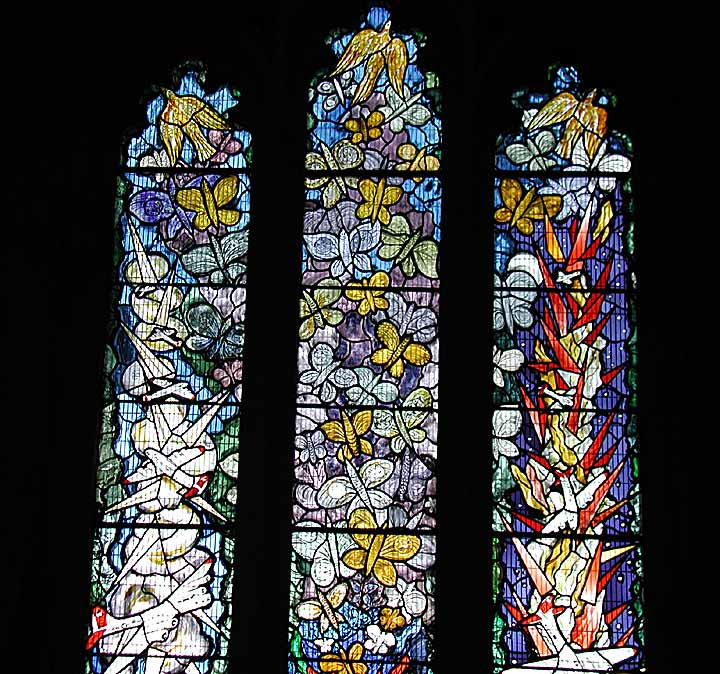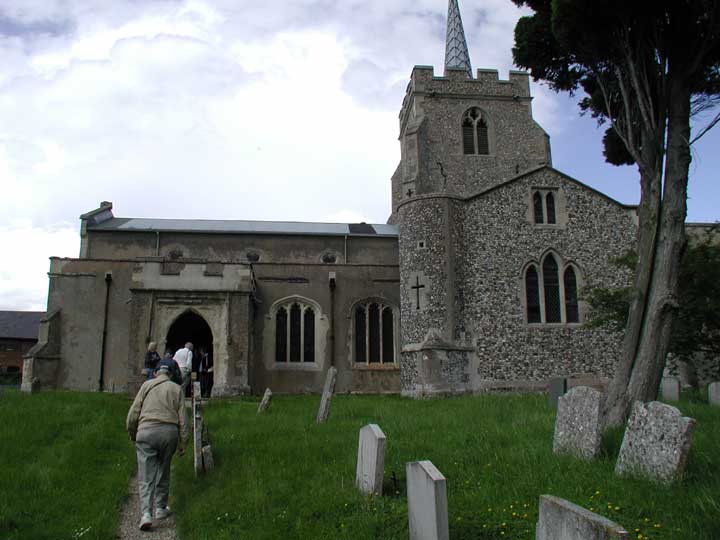The 398th Window at Anstey Church
Below are a series of photographs of the stained glass window at Anstey Church in memory of the 398th men who lost their lives in combat. The conception and completion of this extraordinary endeavor was undertaken by the UK Friends of the 398th and financed through contributions from England and America. The names of all men who lost their lives in combat while serving with the 398th Bomb Group stationed at Nuthampstead (8th AF Station 131) are etched in the center panel around their individual Squadron insignia.
Randy Stange, 398th member and son of 398th veteran Raymond P. Stange, took the Anstey photographs on June 10, 2002 and the text was contributed by Wally Blackwell, President 398th Bomb Group Memorial Association. If you would like to add information about the the Anstey Window, please contact our 398th Group Historian - Lee Anne Bradley. The Photo Reference Number is PR05.

The above photograph of the 398th Memorial Window that is installed in St. George's Church at Anstey, England does not do justice to the real thing. This spectacular stained glass window was dedicated on June 11, 2000 during the 398th veteran's return to the Nuthampstead 398th home base area. The specially designed memorial window was unveiled by the Duke of Gloucester, Churchwarden Sir Roger du Bouley and the UK Friends of the 398th headed by Wilfrid Dimsdale. The dedication service was conducted by the Church Rector, the Reverend Gerald Drew. The conception and completion of this extraordinary endeavor was undertaken by the UK Friends of the 398th and financed through contributions from England and America. The names of all men who lost their lives in combat while serving with the 398th Bomb Group stationed at Nuthampstead (8th AF Station 131) are etched in the center panel around their individual Squadron insignia. The Artist felt that because not all those who lost their lives were Christian, there were some Jews and there were certainly some agnostics. Those thoughts suggested iconography that was not solely Christian. The artist turned primarily to the old Testament rather than the new for his inspiration, and in particular the Journey of the Israelites out of Egypt. At the bottom of the center light is a reminder of the engulfment of Pharaoh's armies when the Red Sea closed over them - an archetypal of the defeat of an enemy in the face of all odds. The center panel is taken up with an ever-expanding moving mass of butterflies. The butterflies are symbols of flight and transformation of the soul after death. Some of the butterflies are imprinted with the insignia of the four 398th Squadrons. Most butterflies are silvery white, in contrast to the dramatic reds, blue and greens at the bottom of the Red Sea . Some have wings golden yellow that are distributed up and across all three lights and can be seen as an unobtrusive representation of The Cross. |
The left panel depicts the Old Testament Exodus Pillar of Smoke which led the Israelites by day, while the right panel depicts the Pillar of Fire which led them by night. B-17 Flying Fortresses, marked with the 398's Triangle W identification, red tail and red wing tips, provide a moving evocation of daylight bombing. The same aircraft can be seen in the right panel descending out of the pillar of fire as night falls, a vivid reminder of the chaos and violence out of which those who survived emerged. ArtistThe artist for the creation of the memorial window was Patrick Reyntiens. Mr. Reyntiens was born in 1925 and educated at Ampleforth and the Edinburg College of Art. He served in the Scots Guards in WWII and has been the Head of Fine Art at the Central School of Art and Design in London. His career includes work at Westminster Abbey, Coventry Cathedral and the Thomas White Memorial Window within the Washington Cathedral in Washington, DC.
See also:
|

The ChurchIn 1086 there was a priest at Anstey, which means that well before 1066 when England was invaded by William the Conqueror there was a Christian community there. Parts of the present church date from the late 12th century, thus the 398th Memorial Wall is a part of the fabric of this ancient building and will be there for all time. The window faces south into the sun which gives a beautiful view from within. It is a perpendicular three light window measuring eight feet high by eleven feet wide overall and is the first window to the right of the entry door. The Church is located a few miles, just over the hill, from the old 398th airbase area in Nuthampstead. The site of the castle that protected the Church in medieval times is behind the Church in this view. The remaining portion of the moat of the castle is the location of the 398th B-17 crash site that occurred on October 15, 1944. |
Viewed from the outside, the 398th Memorial Window is at the right of the entrance door that the congregation is approaching. In keeping with "interesting” names of the lanes and roads in and about this part of England, the path to the Church entrance in use has a sign that identifies it as "Pains End." Nothing can be more appropriate to this picture than the quote from the Church history "Before and after the service the Bells of St. George's Church will be rung." These bells include the 5th bell, dedicated to St. George, which was cast in 1490 and hung in the Tower before Columbus set sail for America, where it has proclaimed the gospel ever since. |


The above two closeups are just a small portion of the overall window detail. The 293 names of the 398th crewmen lost in combat were etched in the glass quite randomly by the artist. Discovering the location of the names of loved ones in the window has taken a great deal of time and not all are known. The only guide available is that the names of those lost are clustered around their individual Squadron logos. |
Randy Stange has been able to successfully photograph portions of the window and capture names. Thus, Gertrude Wells Neff found and viewed the name of her husband, William E. Wells, 600 Squadron Pilot, KIA on April 8, 1945, during the June 9, 2002 Memorial Service held in the Church. It is hoped that with time and patience, perhaps all 293 names will be mapped and available for visitors viewing the window. |
